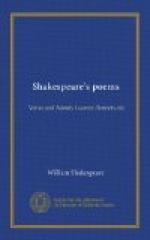
|
| Name: _________________________ | Period: ___________________ |
This test consists of 15 multiple choice questions and 5 short answer questions.
Multiple Choice Questions
1. Which techniques are used in line 838, "love is wise in folly foolish witty"?
(a) Analogy, paradox, and anthimeria.
(b) Paradox, oxymoron, and chiasmus.
(c) Anthimeria, oxymoron, and paradox.
(d) Chiasmus, anthimeria, and analogy.
2. What technique is used in line 899, "Bids them leave quaking, bids them fear no more"?
(a) Anthimeria.
(b) Anaphora.
(c) Antithesis.
(d) Anadiplosis.
3. What technique is used in lines 1123 and 1124, "She looks upon his lips, and they are pale;/ She takes him by the hand, and that is cold"?
(a) Personification.
(b) Symbolism.
(c) Parallelism.
(d) Metonymy.
4. What technique is used in line 640, "They that thrive well, take counsel of their friends"?
(a) Aphorism.
(b) Apostrophe.
(c) Antimetabole.
(d) Paralepsis.
5. What is Venus compared to when she hears the sound of the hunting dogs baying?
(a) Someone who sees a poisonous snake.
(b) A doe rushing to feed her fawn.
(c) A soldier deserting the battlefield.
(d) A lamp brighter than the sun himself.
6. What do Venus's descriptions of the rabbit, fox, and deer have in common?
(a) They stress how fast and clever these animals are.
(b) They stress how numerous and easily spotted these creatures are.
(c) They stress the timid and retiring nature of these animals.
(d) They stress that all three yield delicious meat and useful skins.
7. What does Venus say will die with Adonis?
(a) Beauty.
(b) Death.
(c) Chaos.
(d) Love.
8. In line 1032, whose eyes does the speaker compare to "stars asham’d of day"?
(a) The boar's.
(b) Venus's.
(c) Love's.
(d) Adonis's.
9. Where does Venus go first thing in the morning?
(a) A mossy hillock.
(b) A garden pond.
(c) A copse of oaks.
(d) A myrtle grove.
10. What is the most logical definition of the word "fair" in the context of line 1083, "Having no fair to lose, you need not fear"?
(a) Justice.
(b) Beauty.
(c) Joy.
(d) Calm.
11. What does Venus mean when she says, in lines 649 and 650, "For where love reigns, disturbing jealousy/ Doth call himself affection’s sentinel"?
(a) Love is stronger than jealousy and can preserve affection against it.
(b) When a person is ruled by love, other relationships suffer.
(c) When a person is in love, jealousy sounds frequent alarms.
(d) Love upsets jealousy because it considers affection more important.
12. What technique is used in lines 819 and 820, "Till the wild waves will have him seen no more,/ Whose ridges with the meeting clouds contend"?
(a) Onomatopoeia.
(b) Paradox.
(c) Alliteration.
(d) Innuendo.
13. What does Venus refer to as "ugly, meagre, lean"?
(a) Life.
(b) Lust.
(c) Death.
(d) Love.
14. Which is the most reasonable interpretation of Venus's motives as she describes hunting a rabbit?
(a) She intends to illustrate how knowledgeable she is about hunting.
(b) She intends to make it sound as exciting as hunting a boar.
(c) She intends to shame Adonis into choosing to hunt rabbit instead of boar.
(d) She intends to show Adonis how sympathetic she is toward prey animals.
15. For what reason does Venus suggest the sun and wind took pity on Adonis's tears?
(a) Because of his youth.
(b) Because of his beauty.
(c) Because of his morality.
(d) Because of his kindness.
Short Answer Questions
1. What does Venus tell Adonis will be the cause of him tripping and falling?
2. In the simile discussing the impact of an earthquake on a king's subjects, what does the speaker say causes earthquakes?
3. What is Venus's motive for flattering death?
4. In the conceit that Venus concludes her speech with near the end of the poem, what two things are compared?
5. What does Venus compare to an informer and a spy?
|
This section contains 634 words (approx. 3 pages at 300 words per page) |

|




